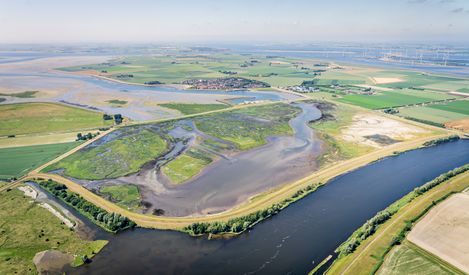PR 00304: verschil tussen versies
(Nieuwe pagina aangemaakt met ' {{Project config}} {{Project |Name=Rammegors Tidal Restoration |Supercontext=Building with Nature |Start date=2015/12/07 |End date=2024/12/31 |Summary=Coming soon....') |
Geen bewerkingssamenvatting |
||
| (4 tussenliggende versies door 2 gebruikers niet weergegeven) | |||
| Regel 1: | Regel 1: | ||
[[Bestand:Rammegors.jpg|miniatuur|469x469px|The nature area Rammegors.]] | |||
In order to protect the Netherlands from the impacts of climate change, the Dutch government placed a variety of dikes, dams and barriers to the low-lying Southwestern delta. The Eastern Scheldt, once an open estuary, was transformed into a salt water basin with the introduction of a semi-open storm surge barrier. Over the years the amount of intertidal areas has dramatically dropped, primarily due to an imbalance between the existing basin morphology and the tempered tides. This imbalance is also known as a 'sand deficit problem'. There are two options when dealing with this problem, the first is to protect the existing salt marshes, the second is to create new intertidal areas. The project 'Rammegorn Tidal Restoration' focusses on the latter. | |||
Within the project there are a couple goals: | |||
# Increasing the amount of knowledge on the abiotic ( for example groundwater) and biotic (like vegetation establishment, benthic communities) factors that influence the speed of recovery. | |||
# Training of young professionals by improving the knowledge of teachers to be supported by case studies added to the curriculum | |||
# Promoting knowledge circulation within the field by combining all the knowledge within the Delta Expertise site. | |||
'''Research type:''' field research, desk analysis, lab research | |||
'''Location:''' Rammegors, Zealand | |||
'''Contact:''' [https://www.projectenportfolio.nl/wiki/index.php/Gebruiker:Lage0009 Wietse van de Lageweg] | |||
{{Project config}} | {{Project config}} | ||
{{Project | {{Project | ||
| Regel 6: | Regel 18: | ||
|Start date=2015/12/07 | |Start date=2015/12/07 | ||
|End date=2024/12/31 | |End date=2024/12/31 | ||
|Summary= | |Summary=Om Nederland te beschermen tegen de gevolgen van de klimaatverandering heeft de Nederlandse regering dijken, dammen en barrières geplaatst in de laaggelegen Zuidwestelijke delta. Dit heeft geleid tot grote veranderingen in de Oosterschelde. Een sterke afname van intergetijdengebieden is een van de gevolgen van de toevoeging van harde structuren in de Oosterschelde. Dit is vooral te wijten aan een onevenwicht tussen de bestaande morfologie en de getijden, ook wel het 'zandhongerprobleem' genoemd. Het project 'Rammegors Tidal Restoration' richt zich op de creatie van een nieuw intergetijdengebied. | ||
|Show summary=Nee | |Show summary=Nee | ||
|SummaryEn=In order to protect the Netherlands from the impacts of climate change, the Dutch government placed a variety of dikes, dams and barriers to the low-lying Southwestern delta. This has led to quite some changes within Eastern Scheldt. A strong decrease in intertidal areas is one of the consequences of the addition of hard structures into the Eastern Scheldt. This is mainly due to an imbalance between the excisting morphology and tempered tides, also called a 'sand deficit problem'. The project 'Rammegors Tidal Restoration' focusses on the creation of a new intertidal area. | |||
Research type: field research, desk analysis | |||
|Contact person=Gebruiker:Lage0009 | |Contact person=Gebruiker:Lage0009 | ||
|Stakeholder=STKH 00069,STKH 00070,STKH 00064,STKH 00061, | |Stakeholder=STKH 00069,STKH 00070,STKH 00064,STKH 00061 | ||
|HZ theme=Water, | |||
|SDG=Leven in het water,Leven op het land, | |||
|Show extra=Nee | |Show extra=Nee | ||
|Show navigation tree=Ja | |Show navigation tree=Ja | ||
Huidige versie van 24 aug 2022 om 15:29
In order to protect the Netherlands from the impacts of climate change, the Dutch government placed a variety of dikes, dams and barriers to the low-lying Southwestern delta. The Eastern Scheldt, once an open estuary, was transformed into a salt water basin with the introduction of a semi-open storm surge barrier. Over the years the amount of intertidal areas has dramatically dropped, primarily due to an imbalance between the existing basin morphology and the tempered tides. This imbalance is also known as a 'sand deficit problem'. There are two options when dealing with this problem, the first is to protect the existing salt marshes, the second is to create new intertidal areas. The project 'Rammegorn Tidal Restoration' focusses on the latter.
Within the project there are a couple goals:
- Increasing the amount of knowledge on the abiotic ( for example groundwater) and biotic (like vegetation establishment, benthic communities) factors that influence the speed of recovery.
- Training of young professionals by improving the knowledge of teachers to be supported by case studies added to the curriculum
- Promoting knowledge circulation within the field by combining all the knowledge within the Delta Expertise site.
Research type: field research, desk analysis, lab research
Location: Rammegors, Zealand
Contact: Wietse van de Lageweg

